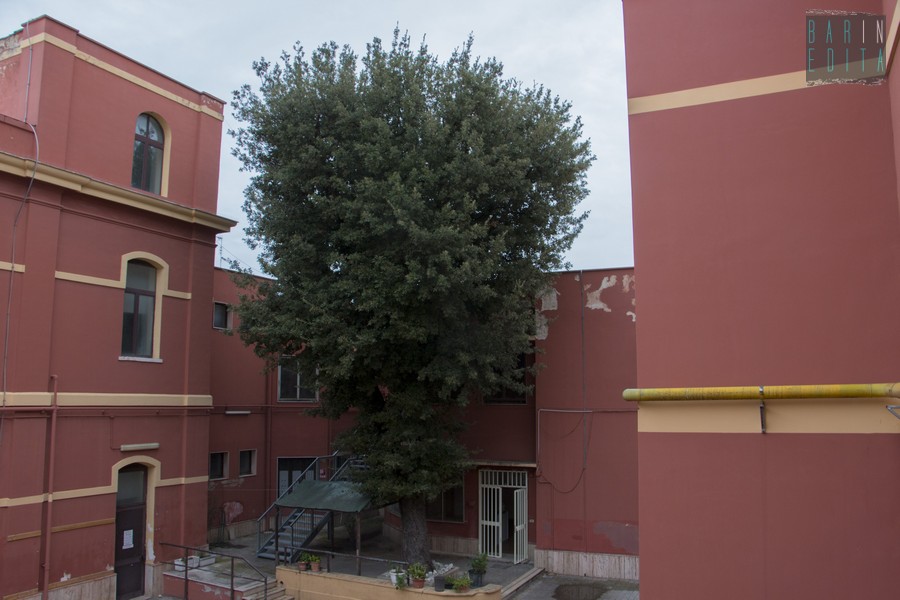
Carbonara Oak
This post is also available in:
 Italiano (Italian)
Italiano (Italian)
The holm oak of the Carbonara primary school has been classified, along with the pine of the Carrassi district, as a “Monumental” tree by the Municipality of Bari; both plants are, in fact, incredibly old and huge, having survived to numberless human interventions in the surrounding landscape.
This great “green guardian” majestically stands in the inner courtyard of “Armando Diaz” primary school in Carbonara. It is a 39.3-ft high holm oak with a circumference of 7 ft. and a leathery, dark brown trunk which protrudes very thick branches with small and thick, oil-green leaves. Its thick foliage seems to reach for the very flights of stairs and the windows of the school.
Despite its proximity to the building, this monumental tree is in very good health, constantly growing and welcoming all the local pupils.
Quercus ilex
-biology and ecology
The holm oak is a tree which can grow up to 82 ft, with an evergreen, dense, globular and slightly expanded crown. The leaves are alternate, persistent, leathery, and grow in many different shapes – the can be as long as 2.75 inches, with a short petiole. Their upper side is glabrous, dark green and shiny, while below it appears rugged and whitish. The acorn can be as long as 1.18 inches.
It is a thermophilic species typical of the Mediterranean scrub, found from sea level up to 600 m (1500 m in the Apennines) on soils not too rich in clay.
In Italy, this species is most widespread in the Ionian and Tyrrhenian regions, as well as on the major islands, while on the Adriatic side it is found quite sporadically.
There are two groups of relic trees belonging to warmer periods on the Euganean Hills and around the city of Ferrara.
The northernmost point of growth of the holm oak is in the Carnic Prealps, on vertical cliffs exposed to the south.
The holm oak is an evergreen plant with leathery leaves that form a dark green crown.
The species is xerotolerant, prefers protective shading in the juvenile phase and adapts well to different types of soils but avoids clayey-compact ones with any water stagnation.
The wood is hard and difficult to process and season as it tends to warp and split. It was once used to build tools or parts of farming wagons due to its extreme durability. It can be used as excellent fuel or very good coal.
Distribution:
The holm oak grows throughout the Mediterranean basin but in Egypt, while in Libya it was probably introduced by man. However, it is a species more widespread in the western part of Northern Africa, especially in Algeria and Morocco, throughout the Iberian peninsula (where it is one of the main trees in the dehesa – a multifunctional, agrosylvopastoral system).
In Mediterranean France and Italy, it tends to grow in single-species woods of remarkable considerable size. Farther east, starting from the Balkans, it can be found in mixed woods and only on soils with adequate humidity. The same thing happens along the Turkish coasts of the Black Sea.
In Italy, the Quercus ilex is most widespread on the islands and along the Ligurian, Tyrrhenian and Ionian coasts; on the Adriatic side, tree populations are more sporadic and disjointed (except for Puglia, Abruzzo and Marche).
Small groves are also present in the Prealps along the lake shores of the lakes, in the Euganean Hills, in Friuli-Venezia Giulia, in Romagna up to the Bolognese-Imola territory, and in the Mesola wood (around Ferrara).
The holm oak is the Mediterranean tree par excellence, present spontaneously in all regions of Italy except in the Aosta Valley, but much more abundant in Mediterranean Italy.
Importance and applications
Importance and Use:
The holm oak is widely used as an ornamental plant, in parks and / or large gardens.
It is well suited for urban green areas, tree-lined streets, embankments and noise barriers.
Well tolerating the pruning, it can be grown as a sapling and used in small gardens or along the avenues. It also grows well near the sea and it is widely used for reforestation of exposed, uncultivated and hilly areas in central-southern Italy.
This species is grown mainly in coppice for the production of firewood; it grows well even difficult soils, while its sucker regeneration is much better than that of deciduous oaks.
In the past, the acorns were used to prepare a surrogate of coffee and as fodder for pigs, rabbits, goats, turkeys, and other poultry. Sturdy handles for hoes were often made with holm oak wood as well.
This post is also available in:
 Italiano (Italian)
Italiano (Italian)
Contatti
Rione Carrassi - 70124 Bari(BA)
